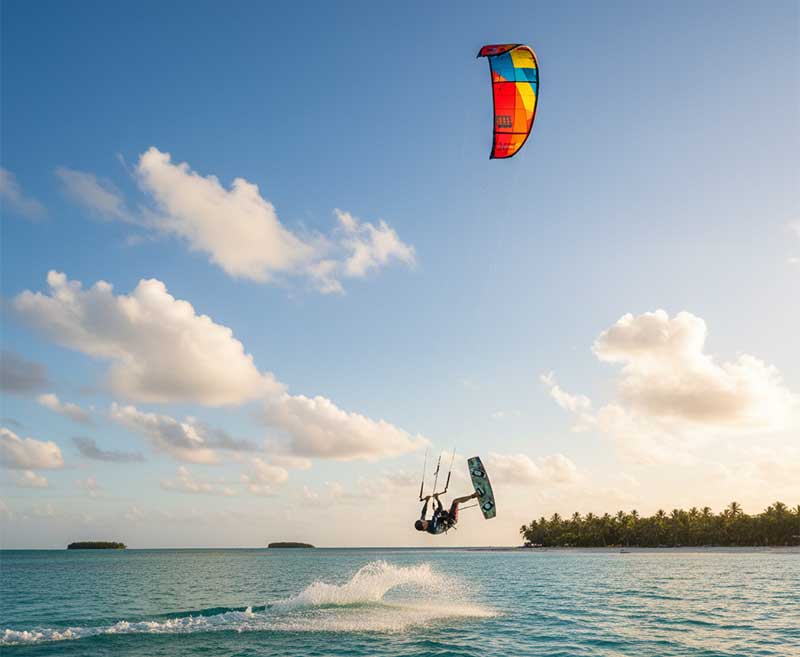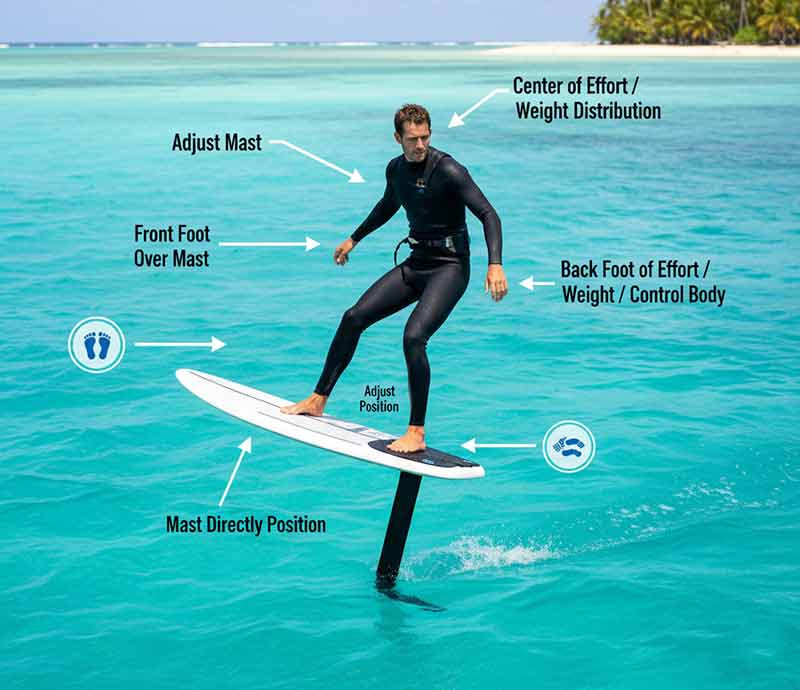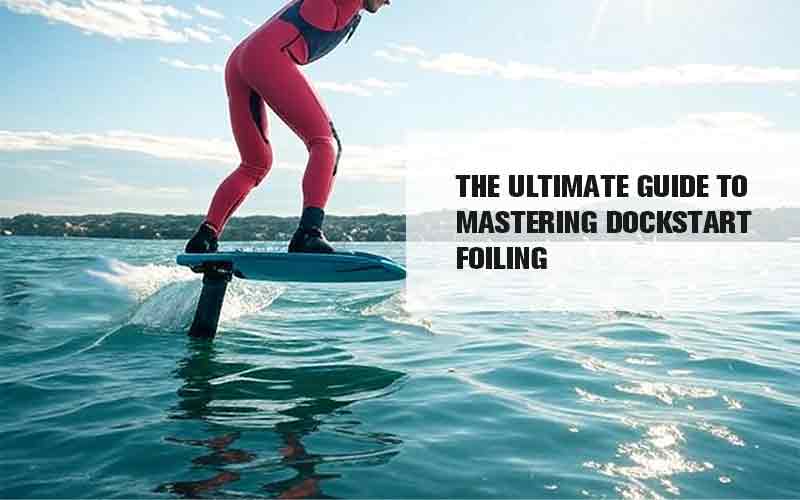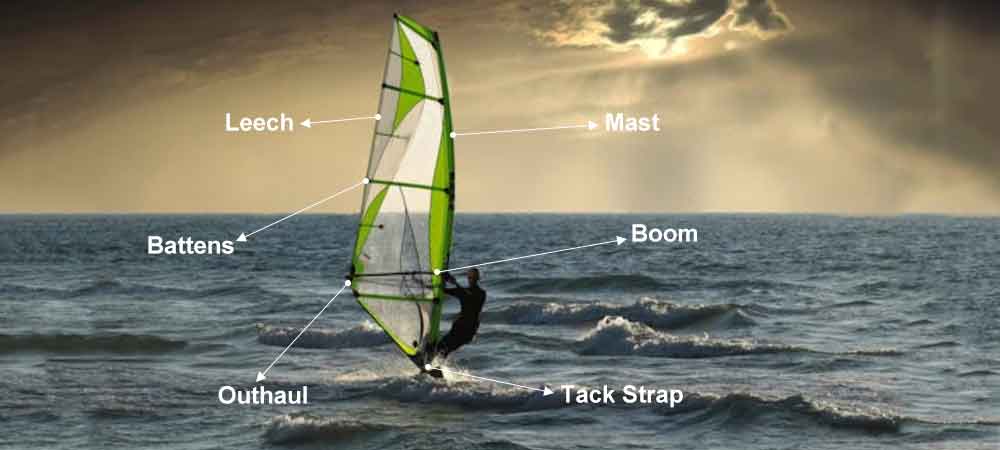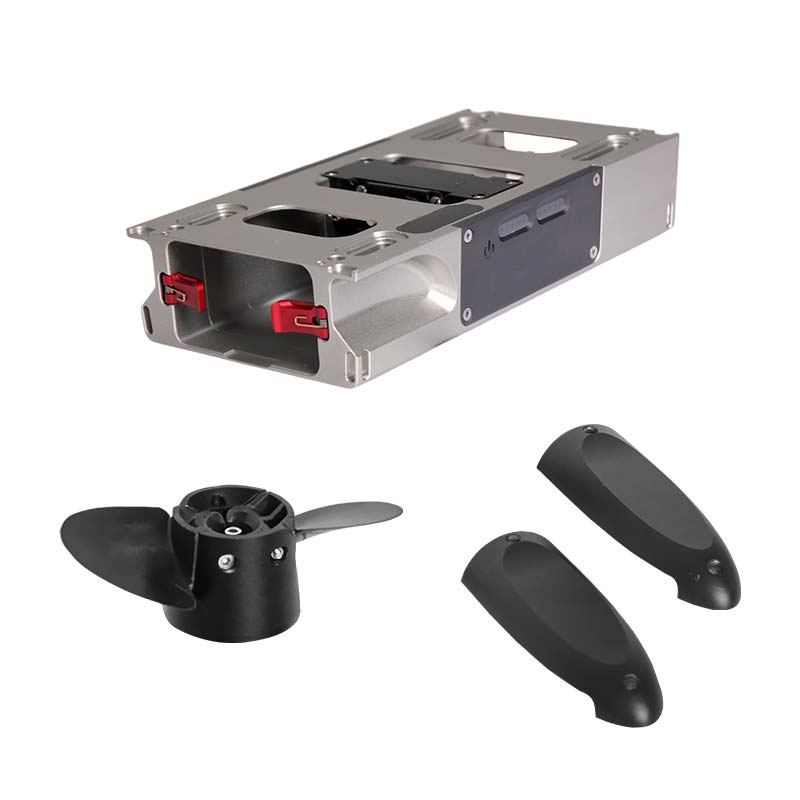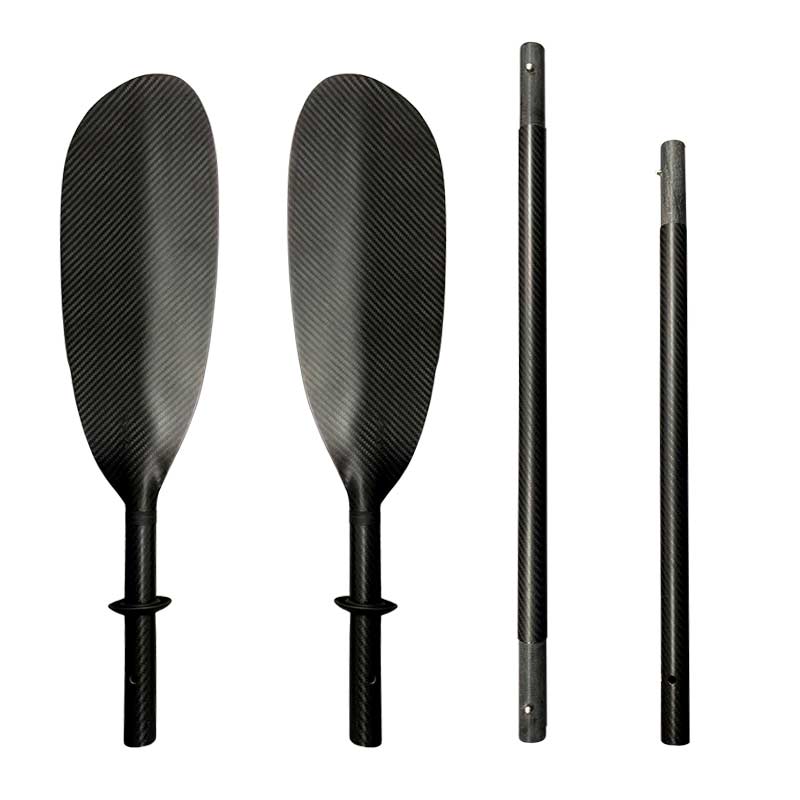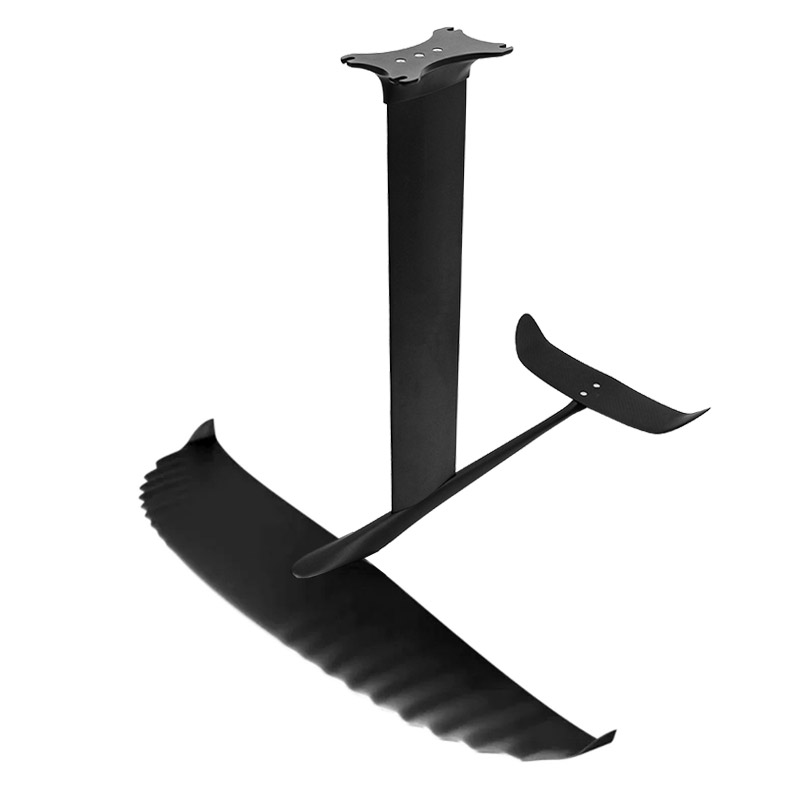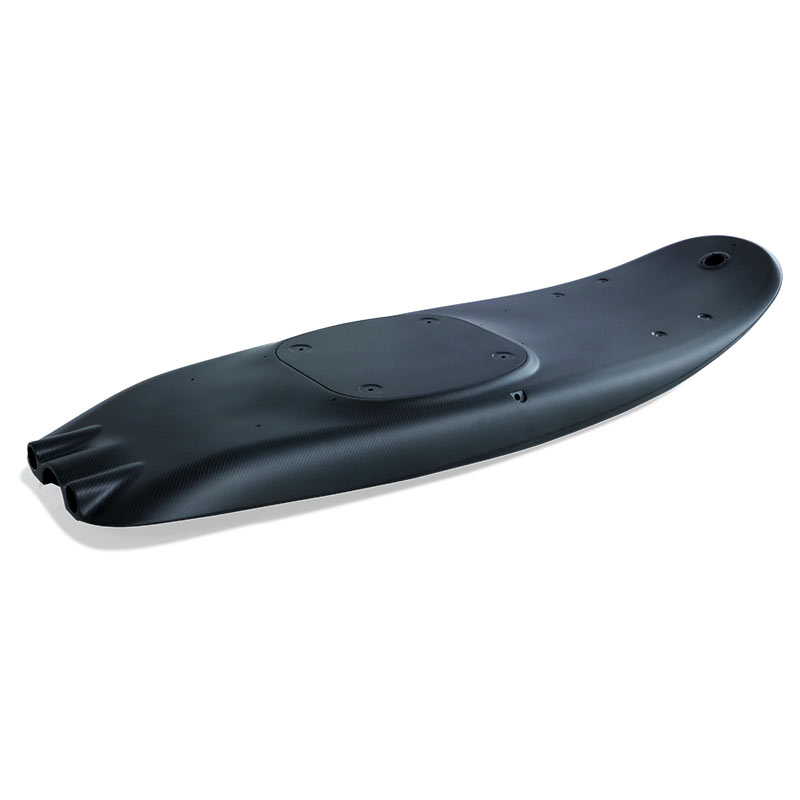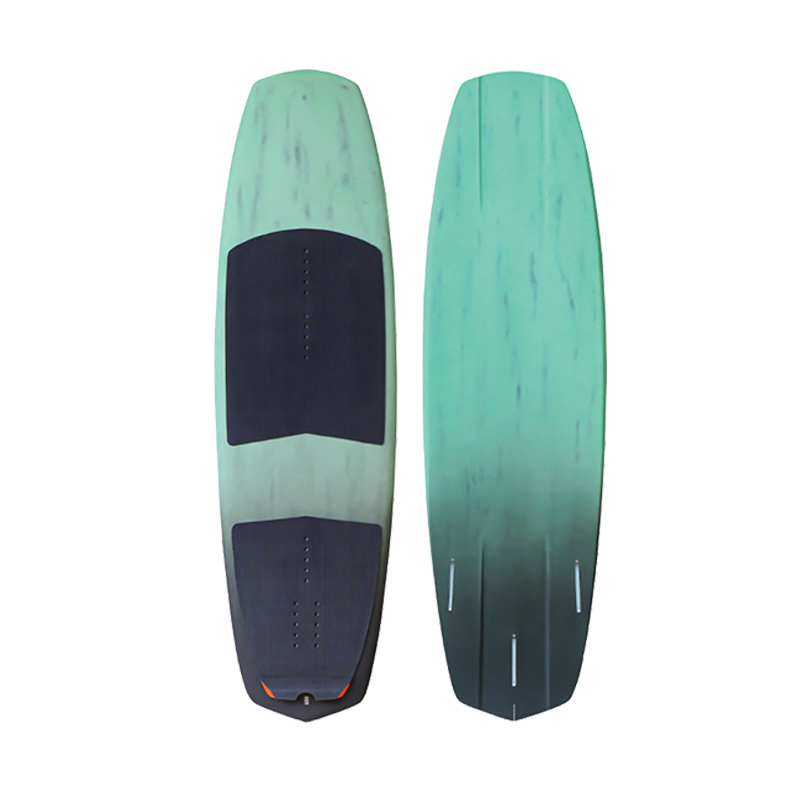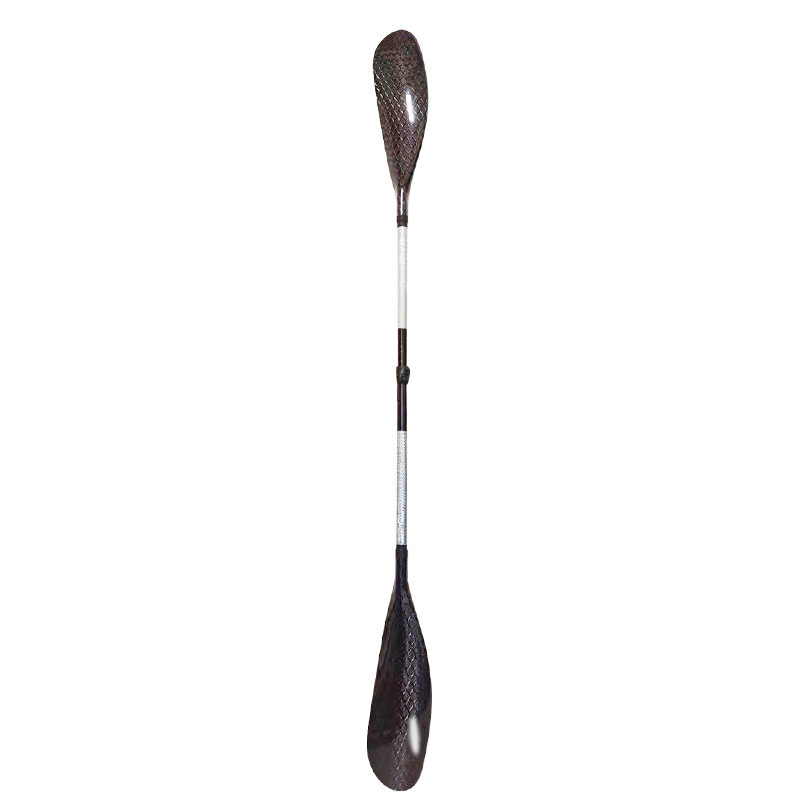Sky kitesurfing is an exciting and thrilling water sport that combines gliding and surfing. The principle behind kitesurfing is to connect a surfing kite to a control bar with a strong rope. The control bar is used to manipulate the kite’s altitude, descent, and direction, while the rider uses a board beneath their feet to glide on the water and even perform aerial maneuvers. Generally, kitesurfing can be divided into two types: Kite Surfing and Kite Foiling.

This article will show you about the gear to safety for sky kitesurfing beginners, I hope it will be helpful for you. And welcome to share this with other people if needed.
Main Kitesurfing Gears
The equipment is the basics for kite surfing, in this section, I will do some introduction about it.
Kite:
Kites used for kitesurfing come in different types, including frame kites, foil kites, and inflatable kites.
- Frame Kites are similar to regular technical kites but are suitable only for very skilled users, as they are difficult to relaunch once they fall into the water.
- Foil Kites do not have a frame and are shaped by multiple control lines. They are ideal for light wind areas but are more expensive, have complex structures, and are not as flexible in operation. After falling into the water, they are also difficult to relaunch, and they only perform well within a narrow wind range.
- Inflatable Kites are the most commonly used kites for sky kitesurfing. They have inflatable airframes, which are generally divided into C-shaped kites and non-C-shaped kites. A simple way to identify them is whether the kite has control lines or not. Kites with control lines are non-C-shaped kites.
Beginners should choose a safe, easy-to-control, and versatile non-C-shaped kite with good water relaunching capabilities.
Kite Lines:
The kite lines should be able to withstand at least 500 pounds of tension and must have the characteristics of being water-resistant and low in stretch. They should also be UV-resistant. The length of the lines is typically 27 meters. The longer the lines, the more power the kite generates, while shorter lines produce less pull.
Kite Control Bar:
The control bar is the main component used to control the kite’s flight attitude and direction. It comes in different configurations, including two-line, four-line, and five-line systems. The material can vary from aluminum alloy to carbon fiber. Carbon fiber control bars are becoming more popular because they are lightweight and strong.
The control bar is equipped with a kite power adjustment system and an emergency release system. The emergency release system is the most critical safety feature in kiteboarding. When the wind changes suddenly or the kite becomes uncontrollable, the safety release allows the kite to quickly lose power and separate from the rider.
Kite Harness:
A harness is used to help the kite’s pull move the rider’s body with less effort. It is typically worn around the waist, just above the hips and below the chest, and is a full-waist cover (similar to a windsurfing harness, but with some differences). Famous manufacturers of harnesses include Mystic and North.
In addition to the waist harness, there is also the “seat harness,” which wraps around the hips and is similar to a climbing safety belt. The seat harness allows better control over the kite’s power but has gradually been replaced by the waist harness due to the latter’s improved functionality.
Kite Board:
Early kitesurfing used one-way boards modified from surfing boards. These boards are long and have great buoyancy, making them ideal for beginners to practice getting up on the board or to use in light wind conditions. However, one-way boards require the rider to change feet when turning, and their large size makes aerial maneuvers difficult. Over time, these were replaced by twin-tip boards that are lighter and more maneuverable, allowing both racing and freestyle functions. If you are interested in a custom composite kite foil board, or a foil for kitefoiling, welcome to contact us to get the quote.
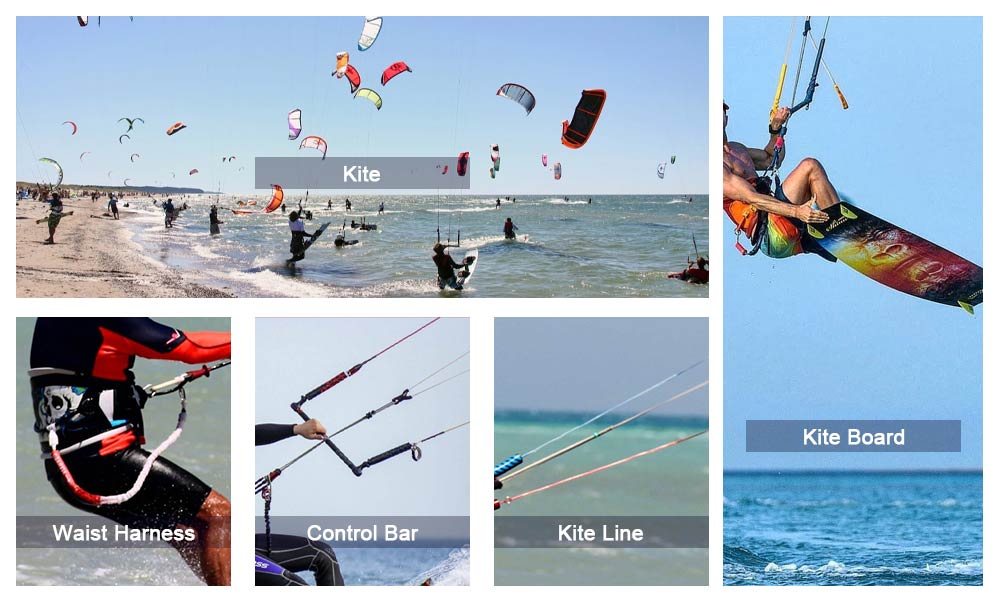
Other Equipment:
Besides the main equipment, additional accessories like harness rings, foot straps, and wetsuits may be required. Beginners may also need to wear a life jacket and helmet.
In addition to water-based kiteboarding, kite sports have extended to land, such as kite skiing, also known as snow kiting.
Beginner To Buy
- Take Proper Training Before Buying Equipment
Equipment from different brands varies greatly in performance. For beginners who have no concept of kiteboarding, purchasing equipment without guidance is like trying to understand something without any knowledge. Proper training and instruction from qualified trainers will help you choose the right gear. - Choose Affordable and High-Performance Equipment
Within your budget, try to choose high-performance equipment, as it will aid in improving your learning efficiency and ensure your safety.
Kite Skiing VS. Sky Kitesurfing

Although the basic principle of kite skiing and kitesurfing is the same — both use the power of the kite to propel the rider forward — there are significant differences in technique and practice due to the differing environments and required equipment.
Environmental Differences
Kite skiing typically takes place in snowy environments, relying on the friction of the snow to help the rider control speed and direction. Ski areas can include mountains, plains, or snow-covered lake surfaces. In contrast, kiteboarding takes place on water, typically in oceans, lakes, or rivers. The friction on water is much lower than on snow, meaning kitesurfers need to rely more on the powerful force of the kite to maintain control and progress.
Equipment Differences
Kites: While both kite skiing and kitesurfing use kites to provide power, the types of kites differ. Kite skiing usually uses foil kites, which provide more stable power at lower wind speeds and are ideal for cold environments. Kitesurfing, however, uses a variety of kites, including inflatable kites and foil kites, which are designed to handle different wind speeds and wave conditions on the water, offering greater maneuverability and flexibility.
Boards: Kite skiers use skis or snowboards, designed specifically for sliding on snow, providing stability and glide. Kitesurfers, on the other hand, use kiteboards, which are lighter and have greater buoyancy, allowing the rider to glide over the water’s surface. Kitesurf boards generally come in two types: directional boards, which are suited for using waves and wind for propulsion, and twin-tip boards, which are better for fast turns and control on the water.
Warmth and Protection
Since kite skiing takes place in cold, snowy environments, insulation is crucial. Kite skiers must wear cold-weather gear, including ski boots, gloves, and face masks, to stay comfortable and safe in low temperatures. Kitesurfing, typically taking place in warmer water environments, requires the rider to wear a wetsuit to protect against the cold water and maintain flexibility. Kitesurfers may also need to wear flotation devices like life jackets for safety.
Technical Differences
Although both sports rely on wind power, the required techniques vary due to the different environments. Kite skiers need to maintain a smooth glide on the snow while using the kite for additional thrust and stability. Kitesurfers, on the other hand, must control buoyancy and speed on the water, and especially when riding the waves, they need to master techniques like wave riding and kitesurfing tricks.
Summary
Although kite skiing and kitesurfing share the same basic power source, their environments, equipment, and techniques differ significantly. Kite skiing uses foil kites and skis or snowboards, requiring special attention to warmth, while kitesurfing uses kiteboards and wetsuits, focusing on control on the water and wave techniques. Both sports are extreme and offer their own unique challenges and attractions.
Famous Kitesurfers
- Prince William
Yes, Prince William is a fan of kitesurfing! He enjoys the sport while vacationing in the Maldives and Seychelles. - Editha Vykvichute
This Victoria’s Secret Angel proves that even angels are ocean creatures! - John Kerry
Even former U.S. presidential candidate John Kerry admits that he enjoys kitesurfing. In fact, many people supported him because the sport made him look trendy. - Ricky Martin
This Latin pop superstar enjoys kiteboarding on beaches worldwide! You might just spot him at a kitesurfing location. - Larry Page
Google’s co-founder trained in Alaska’s cold waters in 2009 and embarked on a major kitesurfing adventure. - Richard Branson
The legendary British billionaire invited former U.S. President Barack Obama to the British Virgin Islands after his term ended to enjoy kitesurfing.
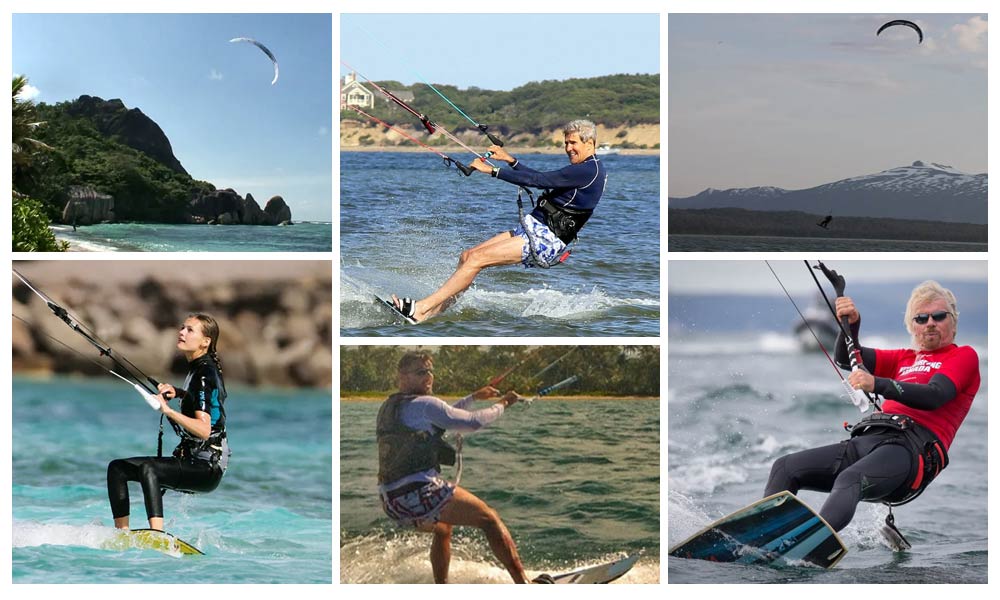
Why Is Kitesurfing So Awesome?
- Kitesurfing Is Super Fun!
The most important reason: gliding over the water, practicing new tricks, achieving a sense of accomplishment, and meeting good friends. And the joy you experience in the sport is like no other. - Sky kitesurfing Is Good for Your Health
Compared to windsurfing, kitesurfing requires much less strength. However, it does require skill, and you’ll engage muscles you didn’t even know existed! This full-body workout not only relieves stress but also boosts your immune system. - Kite surfing Can Help You Unwind
Water, wind, and the use of natural forces to practice the sport will help release the stress of daily life, leaving you with a sense of relaxation. And after enjoying a perfect sunset on the beach, you’ll sleep like a baby. - Kitesurfing Keeps You in Peak Condition
Have you heard that kitesurfing helps you stay in peak condition? When you push yourself out of your comfort zone and work hard for something you love, the confidence gained will transcend into other areas of life.
Some Forums For Kite Surfing
Learning kitesurfing can be an exciting and rewarding experience, but having access to reliable resources is crucial for both beginners and seasoned riders. Fortunately, the internet is home to a variety of websites that provide useful information, instructional guides, forums, and community support for anyone interested in kite sports.
Kiteforum.com
Kiteforum.com is one of the most popular and comprehensive online resources for all things kite-related. The site offers a wealth of information, including tutorials, gear reviews, user experiences, and a large community forum. Whether you’re just getting started or looking to improve your skills, Kiteforum provides valuable insights and discussions on technique, safety, and gear.
Extremekites.org
Extremekites.org focuses on providing high-quality content for kitesurfing enthusiasts. The site features a combination of instructional content, gear reviews, and in-depth articles about kite sports. Whether you’re looking for tips on choosing the right kite or understanding the latest kite technology, Extremekites is a solid resource for kite sports aficionados.
Kiteboarding-club.com
Kiteboarding-club.com is another excellent platform that caters to kiteboarding learners. It offers beginner guides, instructional videos, and expert advice on how to master the sport. The site also highlights popular kitesurfing destinations, provides useful equipment comparisons, and discusses common challenges new riders face in the learning process.
TheKiteMag.com
The Kite Mag is an online magazine dedicated to kiteboarding culture, gear, and tricks. It includes detailed product reviews, interviews with top riders, and tips for mastering kite techniques.
Although forums and online resources can provide us with various knowledge and skills related to kite surfing, it is important to note that kite surfing is an extreme sport with inherent risks. Especially for beginners who are still mastering kite control techniques and understanding safety measures, incorrect handling could lead to accidents. Therefore, while online learning materials offer valuable theoretical knowledge, it is still recommended to choose a reputable kite surfing training institution for professional lessons.
These institutions are usually staffed with experienced coaches who can provide a safe learning environment, ensure proper kite handling techniques, and teach essential safety skills. Through formal training, not only can learners accelerate their skill development, but it also significantly reduces the risks associated with the sport, allowing them to enjoy kite surfing with confidence and safety.
Risks of Learning Kitesurfing
Previous studies on kitesurfing injuries have shown that the risk of injury is similar to or lower than other sports like surfing or cycling. However, like any extreme sport, it’s important to take precautions to minimize the risk of injury.
- Wind and Weather, kitesurfing relies on wind, and while high winds can be exciting, they also pose a greater risk. Always proceed with caution in challenging conditions.
- Physical Stress and Health, sky kitesurfing requires skill, and mistakes become more likely as fatigue sets in. When your arms feel sore, it’s time to take a break. Be mindful of sunburn and hypothermia risks too.
- Marine Life, In warm climates, jellyfish, sea urchins, and sharks can be a concern. Always take local advice and wear protective gear.
- Beginners Trying Advanced Tricks, Beginners should avoid challenging mane

In Summary
Sky kitesurfing is an exciting water sport that combines gliding and surfing, utilizing a kite to propel the rider across the water. The article covers the essential equipment for sky kitesurfing, including kites, kite lines, control bars, harnesses, and boards, with a focus on helping beginners select the right gear for safety and performance. It also compares kite skiing and kitesurfing, highlighting differences in their environments and equipment.
Sky kitesurfing offers numerous health benefits, such as improving physical condition and reducing stress. Additionally, the article mentions online resources like Kiteforum.com and Extremekites.org, where kitesurfing enthusiasts can find valuable information and community support. While online learning is helpful, the article stresses the importance of seeking professional training from accredited institutions to minimize risks and ensure safe practice. Risks associated with kitesurfing, such as challenging weather conditions and marine life hazards, are also discussed, with advice for beginners on avoiding advanced tricks until they gain more experience.

